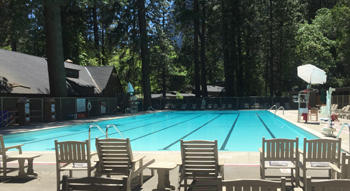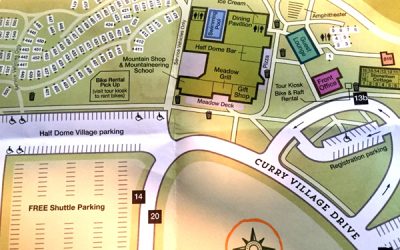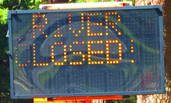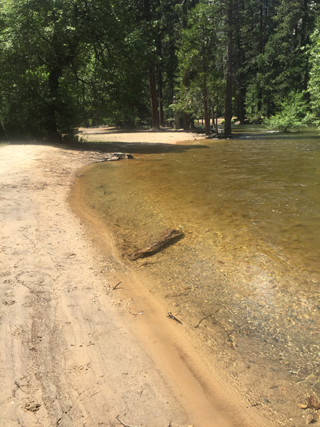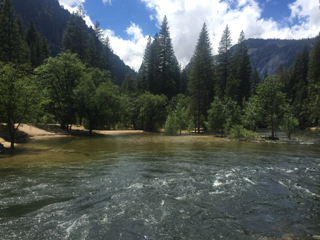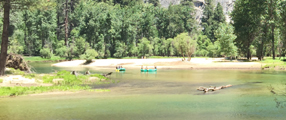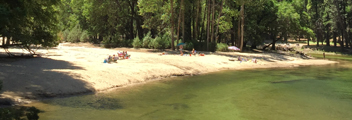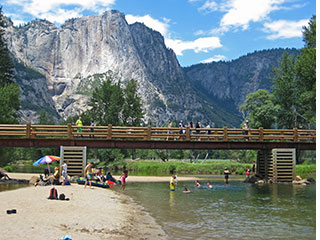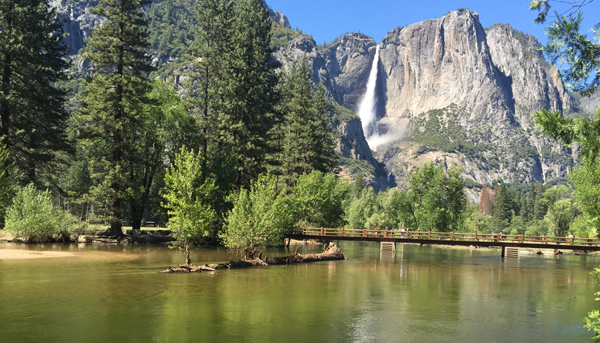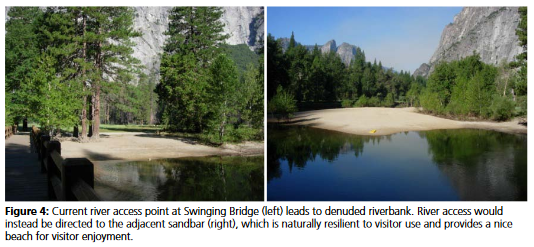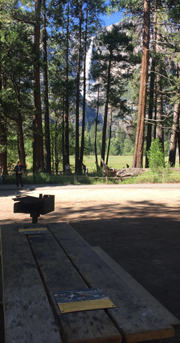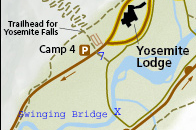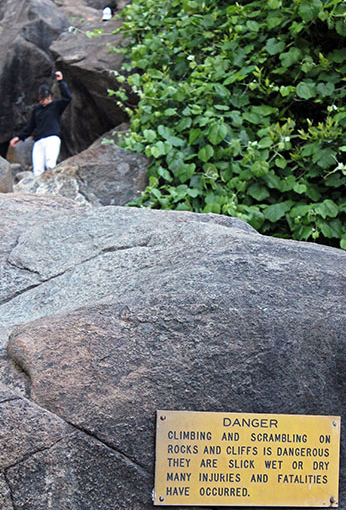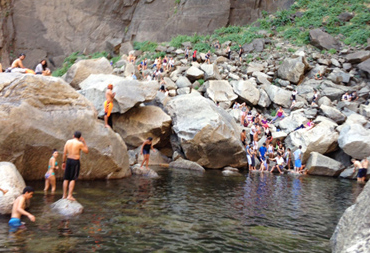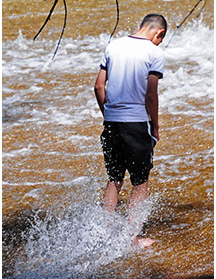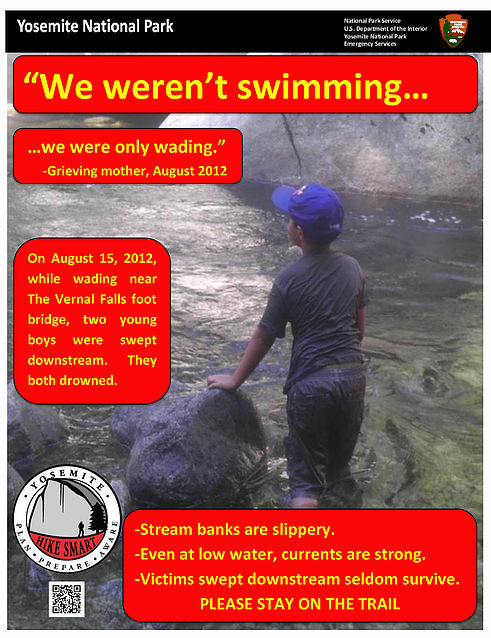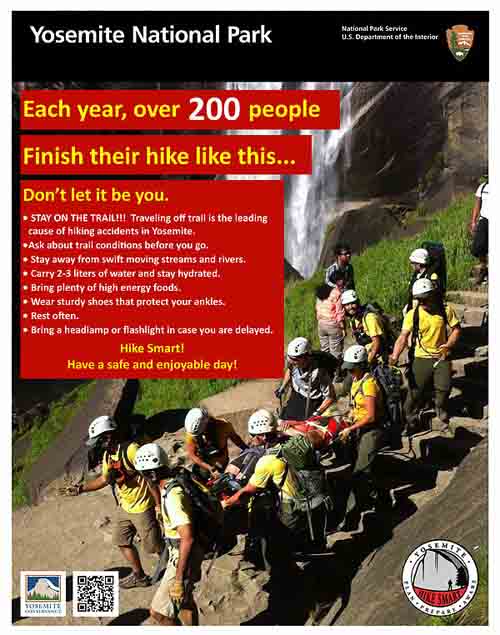In Yosemite National Park there are many lakes, including some with large sandy beaches, and various places along the Merced River, Tuolumne River or creeks that tempt people to swim in the usually cold, sometimes swift water.
You can’t swim everywhere in Yosemite National Park.
The safest places to swim are the hotel pools that have lifeguards, usually open Memorial Day to Labor Day.
And see below for non-swimming pool favorite places to swim, examples of hazards (or even dangers) for non-swimming pool swimming
and advice from a Yosemite NPS rescue ranger on “Where is a good place for visitors to swim in the Merced River?”
Yosemite hotel pools normally open to the public can be closed with little notice during local forest fires. (Example: “Pool will be operating from 2 PM – 7 PM until the smoke conditions change from the (name of) fire.
The hotels with a pool open to the public are
1) Yosemite Lodge:
map with swimming pool and bike rentals pick-up area:

2) Curry Village : 365 day a year shower house and summer swimming pool on the right up the service vehicles only road from the parking lot. The map below shows shuttle bus bus stops 14 and 20, and the road to the shower house / pool (blue rectangle):
People who are not guests at the Lodge and Curry Village (briefly named Half Dome Village) can swim in the pools for a fee:
http://www.travelyosemite.com/things-to-do/swimming/
The hotels with a pool NOT open to the public are
– – – Wawona (briefly named the Big Trees Lodge) has a a swimming “tank”
– – – the Ahwahnee pool is also open only to guests of the Ahwahnee hotel, (open and heated all year, not just in the summer). Please note that instead of traipsing around the Ahwahnee Hotel lobby in your wet swimsuit, hotel guests staying in the main building can take the elevator to the first floor (mezzanine), turn left as they exit the elevator, go down a long hall to stairs leading directly down to the pool. Your room key opens the locked gate to the pool. If there is also a padlock on the gate, it is not open (evening/overnight or due to occasional weather/chemical problems or when a large branch from a nearby tree falls into the pool). See also the Ahwahnee Hotel Map
During pool repairs originally scheduled for October 2022 – March 2023, the park service took care to be sure the native frogs living around the Ahwahnee swimming pool were protected:
https://parkplanning.nps.gov/projectHome.cfm?projectID=98956
– – – – – – – – – – – – – – – – – – – – – – – – – – – – – – – – – – –
see also: Yosemite valley rafting advice
– – – – – – – – – – – – – – – – – – – – – – – – – – – – – – – – – – –
THUNDER STORMS are an issue for swimmers in swimming pools and in lakes, rivers. . .
Most of the time pools stay open in the rain, but lifeguards know to close a pool at the first sound of thunder, and not let people back in to swim until a half hour after the last thunder. People swimming at beaches/in lakes should follow the same safety rule. Wise people don’t swim when thunderstorm clouds are building up. The Park Service warns: “Drenching thunderstorms can form in a matter of hours . . . storms often bring intense rain, hail, and lightning strikes, particularly in mid to late afternoon (but can occur at any time).” With the wind that storms can bring, you could be quite cold on your walk back from that swimming hole, so rain gear and warm layers could be wise even on a warm summer day.
– – – – – – – – – – – – – – – – – – – – – – – – – – – – – – – – – – –
Open water swimming in Yosemite in lakes, rivers, creeks
has safety issues different from swimming pools:
MICROBES
You can get quite sick if you drink water from bodies of water in Yosemite without purifying it first, so try to not accidentally drink water from the body of water you are swimming in. The Red Cross lifeguard manual says: “Children, the elderly and people with weakened immune systems have a greater chance of getting sick…” The Park Service warns: “Giardiasis is an intestinal disease caused by Giardia lamblia, a water-borne protozoan. Giardia is carried by humans and some domestic and wild animals. All water or melted snow must be treated by boiling for at least five minutes, using an iodine-based purifier, or using a Giardia-rated water filter. Associated symptoms include chronic diarrhea, abdominal cramps, bloating, fatigue, and loss of weight. Treatment by a physician is necessary to kill the organisms.”
purifying drinking water while hiking, camping and backpacking
– – – – – – – – – – – – – – – – – – – – – – – – – – – – – – – – – – –
Check out the size (16 inches?) of the trout nibbling at his Teva!
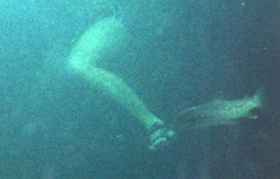
COLD, SWIFT WATER
If you choose to swim in a lake, creek or river, please note that without a lifeguard, and with cold, sometimes swift water you are taking more risks.
Yosemite warns: “Choose swimming areas carefully and swim only during low water conditions. Avoid areas of “whitewater” where streams flow over rocky obstructions” … “all natural waterways have hidden dangers: strong, unpredictable currents; unseen drop-offs along the river bottoms; and submerged logs and rocks. All children need close supervision by an adult who can swim. If you are an adult who doesn’t know how to swim, do not enter the water!” . . . “Never swim or wade upstream from the brink of a waterfall, even if the water appears shallow and calm. Each year unsuspecting visitors are swept over waterfalls to their deaths when swimming in these areas.”
The pressure of water against your lower legs as you wade may make it feel like a slow current, but if your whole body is pushed against a rock by that same current you can find yourself submerged and stuck against that rock.
.
– – – – – – – – – – – – – – – – – – – – – – – – – – – – – – – – – – –
The park service warns:
“Swimming:
Always supervise children closely.
Choose swimming areas carefully and swim only during low water conditions.
Avoid areas of “whitewater” where streams flow over rocky obstructions.
Never swim or wade upstream from the brink of a waterfall, even if the water appears shallow and calm. Each year unsuspecting visitors are swept over waterfalls to their deaths when swimming in these areas.”
It would be impossible to warn you of every danger at this webpage, but please also read the info at this website:
https://www.nps.gov/yose/planyourvisit/watersafety.htm
https://www.nps.gov/yose/blogs/yosemite-s-rivers-present-hazards-even-in-september.htm
and see the Yosemite Water Activities page for the latest on where swimming is not allowed in the park:
https://www.nps.gov/yose/planyourvisit/water.htm
– – – – – – – – – – – – – – – – – – – – – – – – – – – – – – – – – – –
How cold is the water in the Merced River in Yosemite valley right now? Scroll down at:
https://waterdata.usgs.gov/nwis/uv/?site_no=11264500
– – – – – – – – – – – – – – – – – – – – – – – – – – – – – – – – – – –
The park service also warns:
Always supervise children closely.
WEAK SWIMMERS AND CHILDREN
You should keep your children within arms reach at a swimming pool or while in/near a river/creek/lake. Many recreation center swimming pools offer lifejackets for children to wear. Wise parents should bring a properly fitting child sized lifejacket for when children play in the lakes/rivers/creeks. If you or your kids don’t swim well, look for a shallow inlet safely separate from the main river for a water play area.
If your family does swim well, watch other people at a ‘swimming hole’ before you go in. Notice where the current is faster, or where the current tries to bring people under overhanging or partially submerged tree branches, abandoned cables, or narrow gaps between rocks. Notice where the water is too deep, how cold it is and set boundaries for your kids’ use accordingly. The best way to check an area out for safety is to watch others first, then get in and wade/swim yourself. You can do all this without making a scene and embarrassing your teenagers.
Stay awake and in very close proximity of your kids who are playing or swimming (within arms reach to the little ones). Again, have the weak swimmers wear their lifejackets.
If you have the little ones wear their lifejacket while swimming, remember, these aids don’t guarantee safety! Kids who wear these get overconfident and swim out too far. Stay in arms reach of them and keep them in shallow water with no current.
Waterwings are not recommended, even at a swimming pool, as they have been known to creep up or quickly slip up to wrists and leave the child with their face held underwater with not enough strength to get their face to the surface to breathe.
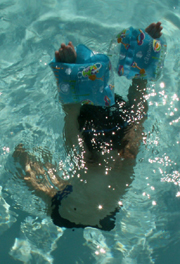
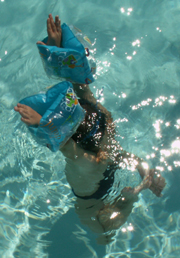
– – – – – – – – – – – – – – – – – – – – – – – – – – – – – – – – – – –
NO DIVING
It’s not safe to enter the river/lakes head first or hand first in a dive anywhere.
– – – – – – – – – – – – – – – – – – – – – – – – – – – – – – – – – – –
And it is ILLEGAL TO JUMP OR DIVE OFF BRIDGES.
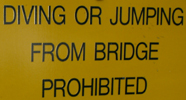
Yes, there is an actual Yosemite regulation: “Jumping or diving from any bridge is prohibited… This activity has resulted in severe injuries to persons who have jumped from bridges into shallow water. Also, people jumping from bridges cause increased water turbidity and shock waves, both of which have a detrimental effect on fish and other components of aquatic ecosystems.”)
Another reason to discourage your group from jumping is that they are role models for others. Your group might be good enough at jumping to not slip or accidentally lean backwards and hit their tailbone or the back of their head on the bridge as they jump, but a child who sees them and tries it might not be. And if one of the group is not sure about it and is being pushed (literally or not) to jump, they might start to jump and their brain will re-consider/panic and they might hesitate in mid-jump, not jump out and away from the bridge, again causing them to impact part of their body on the bridge.
Parents have been cited and paid fines for encouraging their under-age children to illegally jump off bridges.
– – – – – – – – – – – – – – – – – – – – – – – – – – – – – – – – – – –
There are times you should not enter the river, such as before rafting is allowed, or when you see big illuminated signs on the road into the park saying the RIVER IS CLOSED.
THERE ARE PLACES YOU SHOULD NEVER SWIM, posted with warning signs, including Hetch Hetchy reservoir.
You will see many people who ignore the warning signs/barriers,
for example, at Emerald Pool and Silver Apron above Vernal Fall,
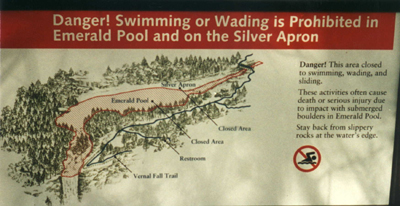
see below for Turning Blue In Emerald Pool
or at the pool at the base of Lower Yosemite fall.
https://www.nps.gov/yose/blogs/four-accidents-in-four-days-at-lower-yosemite-fall.htm
Be sure you are not wading, playing, swimming or trying to cross a river anywhere above a waterfall or rapids. Yosemite warns: “Never swim or wade upstream from the brink of a waterfall, even if the water appears shallow and calm. Each year unsuspecting visitors are swept over waterfalls to their deaths when swimming in these areas.”
People have also suffered grave injuries when they slipped on slick rocks in or out of the water. Please do not ignore warning signs.
Stay on designated trails/ bridges / walkways.
If you decide to go off-trail, please be prepared that you can step between rocks and unknowingly step near a rattlesnake, or “crevices can hide scorpions, spiders, and yellow jacket nests”. https://www.nps.gov/yose/blogs/Nevada-Fall-Rattlesnake-Bite.htm
https://www.nps.gov/yose/blogs/near-drowning-at-vernal-fall-pool.htm
If there is a sign that says DO NOT SWIM . . . don’t swim OR wade OR put your feet in the water to cool off.
In the first picture below, (taken when the river was closed to rafting and any other water activities) it looks like this section of beach along the river is shallow enough for a play area for little kids. But in the second picture, taken from across the river, you can see white water. If the kids got in and got a little excited about fun, they could go too far out in the water quite quickly, and be swept down river with no way to save them.
![]()
The NPS Yosemite guide newspaper featured an interview with a rescue ranger who was asked:
“Where is a good place for visitors to swim in the Merced River?
His answer was: “I think anybody looking for a place to dip in the Merced should do a really comprehensive assessment of the dangers, and if they struggle to understand what a comprehensive assessment of the dangers is don’t get in.
You have be able to look at it and say:
is the water moving or still,
how deep is it,
where does it go,
where does it terminate,
is it dropping into a deep pool,
does it go off an edge,
is it going into an area that is super shallow for the next 100 feet?
It’s not about what am I going to experience right now,
it’s about what will I experience if this all goes wrong.”
Here are a few of the favorite swimming areas in Yosemite.
Help protect the river by entering and exiting the water only on sandy beaches, not through/on plants.
The park service warns: “All children need close supervision by an adult who can swim. If you are an adult who doesn’t know how to swim, do not enter the water!”
You don’t have to climb over huge boulders to get to any of the following recommended swimming holes.
– – – – – – – – – – – – – – – – – – – – – – – – – – – – – – – – – – – – – – – – – – – – – – – – – – – – – – – – – –
Housekeeping Camp , free shuttle bus stop # 12, has a huge wide sandy beach and narrower ones along the river.
Expect more crowded conditions on the beaches at Housekeeping Camp than those in this early-in-the-day photo of the biggest beach, on the western end of the camp:
Map showing Housekeeping Camp, the biggest beach, the pedestrian bridge over the river to other swim beaches, (as well as the laundromat and showers):
http://www.travelyosemite.com/media/330396/housekeeping-camp-property-map_web.pdf
At the map above, notice the pedestrian bridge across the river next to units 48/47 you can use to go to this beach:
– – – – – – – – – – – – – – – – – – – – – – – – – – – – – – – – – – – – – – – – – – – – – – – – – – – – – – – – – –
A short walk from free shuttle bus stop 7 is Swinging Bridge (nope, the bridge does not really ‘swing’ anymore) and a good swimming area (in season) with shallow and deep water, sandy beaches and Yosemite Falls views. In spring and even early summer, when swimming seems like it would be fun, the river can be dangerously fast and the walk from the lodge to this swim area can have moving water along the walkway, thus reminding people it would not be safe to swim!
Compare the photo above, when the water is low enough for safe swimming, to below in June 2017, when the water was quite high and the beaches in the first photo are submerged:
As a part of the Merced River Plan, at Swinging Bridge the park service will be trying to let the overly-used parts of the riverbank on the upstream side of the bridge grow back and encourage people to use the sandy beach on the downstream side of the bridge:
Across the bridge is a large picnic area with tables, grills and accessible vault toilets. Some of the tables have views through the trees of Yosemite falls.
Head towards the river from free shuttle bus stop 7, along a parking lot road and down a path alongside Leidig meadow.
– – – – – – – – – – – – – – – – – – – – – – – – – – – – – – – – – – – – – – – – – – – – – – – – – – – – – – – – – –
At Tuolumne Meadows, the world’s greatest swimming hole has a small waterfall that cascades into a pool that is deep enough for swimming, and also shallow enough for wading/sitting.
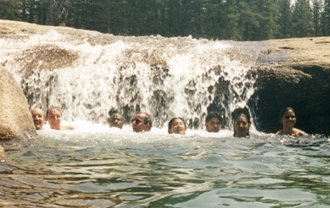
– – – – – – – – – – – – – – – – – – – – – – – – – – – – – – – – – – – – – – – – – – – – – – – – – – – – – – – – – –
At Glen Aulin, when the water is not too swift (and if you stay out from under or above the waterfall) there is a pond at the base of the fall that is actually swimmable in parts of the summer season:
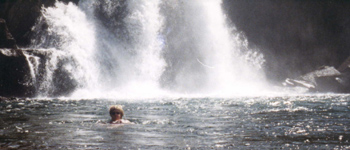
– – – – – – – – – – – – – – – – – – – – – – – – – – – – – – – – – – – – – – – – – – – – – – – – – – – – – – – – – –
But people should not try to swim below most waterfalls. And injuries / deaths occur regularly to people who climb around on rocks, boulder fields below waterfalls
such as at Bridalveil Fall:
(The picture below is from: A Common Yosemite Search and Rescue)
From an article in the Fresno Bee about a deaths / injuries, despite warning signs,
” . . . the subjects hiked to the viewing platform below Bridalveil Fall, then scrambled up the boulder field toward the base of the waterfall (plunge pool area).
According to witnesses, Miu and the other person each slipped off the wet boulders and fell 20 feet near the base of Bridalveil Fall.
Rescuers during both incidents scrambled through the terrain to provide advanced life support medical care to the subjects.” . . .
“. . . Over the last few years at Bridalveil Fall alone, there have been 23 documented incidents in which visitors have slipped and injured themselves.
Yosemite National Park officials are reminding the public that the granite boulders have been polished smooth by falling water and are extremely slippery whether it’s dry or wet.”
___________________________________
Places to take pictures of Bridalveil Fall.
___________________________________
M-a-n-y people have been seriously injured at the base of lower Yosemite Falls, please stay on the trail/bridges/walkways and wade/swim someplace safer.
and from the same news article above in the Fresno Bee,
at lower Yosemite Fall, . . .”person slipped off a boulder, fell into Yosemite Creek and became trapped underwater between several rocks.
The person was able to escape, and bystanders helped the person out of the water.
Rescuers provided medical care and the person was taken by ambulance out of the park for care.”
___________________________________
Places to take pictures of Yosemite Falls
________________________________________________
Even though it can be safe to swim at Swinging Bridge, this happened to non-swimmers at this popular Yosemite Valley river swim area:
“Near Drowning at Swinging Bridge
July 4, 2014 Posted by: Yosemite Search and Rescue at their Lessons From The Field webpage
On the Fourth of July, the parents of a six-year-old girl brought their daughter to the Yosemite Medical Clinic after she nearly drowned in the Merced River. The parents recounted the following story to clinic staff:
Along with her parents and seven-year-old sister, the six-year-old subject was wading in a shallow area of the river, just below Swinging Bridge. The subject’s parents don’t know how it happened, but all of a sudden they saw the subject slipping below the water in what turned out to be a deep section of the river; the last they saw of their daughter was one of her hands reaching skyward before it disappeared. The mother and then the father, both fully clothed, jumped into the water at the spot they last saw their daughter. Neither parent knows how to swim, so they also sank to the bottom of the river. A bystander, watching what had just happened, jumped off the bridge into the river, and with one arm grabbed the six-year-old subject, while with the other arm he pushed the father, who in turn pushed against the mother, up and out of the water. Other bystanders helped the parents out of the water, while the original bystander carried the subject out of the water. The subject never lost consciousness and reported to clinic staff that she remembered the entire episode. The parents estimate she was submerged under the water for 1-2 minutes. After she was rescued, the subject was coughing persistently, but was able to breathe on her own.
About an hour after the near-drowning episode, the subject complained of a stomach ache and vomited multiple times; her parents brought her to the clinic for further evaluation. After consulting with Children’s Hospital Central California, the clinicians at the Yosemite Medical Clinic advised the subject’s parents to have her transported by ambulance to Children’s Hospital for more extensive evaluation and overnight observation.
Submersion injuries can present in a variety of ways. The victim can be completely unresponsive and pulseless or can be awake and oriented and seemingly unscathed. It is worth noting that even subjects without any symptoms that suffer near drowning can still decompensate into respiratory failure up to 8 hours after the injury. It is therefore essential that all near-drowning victims receive further medical assessment.
It is imperative for those playing in and near water in Yosemite to understand that drowning incidents occur not only in fast moving white water, but also in shallow, slow, seemingly benign bodies of water as well. This is particularly true for young children and those who do not know how to swim. According to the Centers for Disease Control and Prevention (CDC), every day in the United States, ten people die from unintentional drowning. Of these ten, two are aged 14 and younger. Children ages 1 to 4 have the highest drowning rates. Research has shown that both lack of swimming ability and lack of close supervision influence drowning risk.
One drowning prevention strategy that is particularly important in Yosemite is close supervision of children when they are in and around rivers and lakes. The CDC recommends that “because drowning occurs quickly and quietly, adults should not be involved in any other distracting activity…while supervising children…” It is worth noting that the adult responsible for the supervision of the child should be comfortable and capable of swimming him or herself. The supervisors of young children should provide “touch supervision,” close enough to touch or reach the child at all times.
Learning to swim is another drowning prevention strategy that is important for both children and adults. If you are planning to vacation in an area with pools, lakes, rivers, or ocean, please consider enrolling you and/or your child in beginner’s swimming lessons. Most local pools, YMCAs, and American Red Cross chapters offer local swimming, first aid, and CPR classes. Visit your city or town’s official website to find out where you can participate in swimming lessons in your area. It could save a life!”
___________________________________
From the National Park Service Morning Report
Upper Delaware Scenic & Recreational River (NY,PA)
Wednesday, July 28, 2004
Drowning in Delaware River
Michael Miranda-Ruiz, 22, and friends were walking and playing in shallow eddy water in the Delaware River near Kittatinny Campground in Minisink, New York, around 8 p.m. on July 23rd. As they moved along, they wandered into the deeper main current. Members of the group began to panic and struggled to get to the shoreline. Bystanders helped them, but noticed that Miranda-Ruiz was missing. They called for help via 911, and rangers and local rescue units responded. Miranda-Ruiz’s body was recovered around 9:40 p.m. by divers. Miranda-Ruiz was a non-swimmer and was not wearing a life jacket. None of the members of the group had ever been swimming in a river. Rangers and state police are investigating.
[Submitted by Al Henry, Chief of Protection]
– – – – – – – – – – – – – – – – – – – – – – – – – – – – – – – – – – –
Teton County (Wyoming) Search and Rescue would like you to know:
“Do not stand in moving water, even if shallow. If your foot gets trapped in the rocks, the current will push you over, wedging your foot tighter, and pushing your head underwater. You will drown. Others have drowned in 2 feet of water this way.”
Water moving over granite can be moving much faster than you realize and the rock slicker than you think. Below an example of a hiker about to slip and take a fall:
This photo is from:
https://www.nps.gov/yose/blogs/five-silver-apron-injuries-on-same-day.htm
– – – – – – – – – – – – – – – – – – – – – – – – – – – – – – – – – – –
The park warns: “Drownings are the number one cause of accidental death in the National Park Service and at Yosemite National Park.
Most Yosemite drowning victims were not swimming or boating but accidentally slipped into the water.
Yosemite’s swift water is more powerful than any swimmer and streams are full of dangerous entrapments.
Yosemite’s highly trained swift water rescue team members are not allowed within one body length of swift water unless they are wearing a personal flotation device (PFD) and helmet, and are tethered to keep out of the water in the event of an accidental slip.
(Hint: how close should you be to swift water?)”
– – – – – – – – – – – – – – – – – – – – – – – – – – – – – – – – – – –
___________________________________________
____________________________
____________________________
___________________________________________
and the tale of people who barely survived swimming in Emerald Pool above Vernal Fall:
“Turning Blue in the Emerald Pool
https://www.nps.gov/yose/blogs/turning-blue-in-the-emerald-pool.htm
July 29, 2016 Posted by: Yosemite Search and Rescue
A brief dip in the Emerald Pool became a near-death experience for two 18-year-old swimmers on July 17, 2016. A group of eight older teens were hiking the Mist Trail above Vernal Fall. Two of the teens, both from Southern California, were familiar with swimming and recreating in the Pacific surf. They reached Emerald Pool as late-afternoon shadows were falling across the canyon.
Two of the teens decided to leave the trail and swim across Emerald Pool. When they tried to return to the trail side of Emerald Pool, the two swimmers struggled with:
A strong current, which was not apparent before entering the water
Cold water temperatures, which quickly accelerated their fatigue
The strong current and cold water thoroughly exhausted both young men. One was surviving the return swim but the other literally was not. The surviving swimmer doubled back to rescue his friend but fatigue overcame both swimmers. Their six companions on shore, though watching in horror, were not able to help. At this point, the young men were now losing their battle against drowning.
During their struggle, an anonymous Good Samaritan entered the water and grabbed the more distressed swimmer just as he was bobbing under the water. The rescuer pulled him to the water’s edge, enabling the other swimmer to self-rescue.
The Good Samaritan, whose identity remains a mystery, left the scene.
The distressed swimmer swallowed water and, although on dry land, was vomiting and barely responsive, even as the first emergency medical responders arrived. His condition was serious enough that a Yosemite Search and Rescue (YOSAR) team had to carry him down to Happy Isles on a litter.
It appears both swimmers will make a healthy recovery.
Lessons Learned:
Emerald Pool is not a swimming pool. Other swimmers have drowned after discovering the challenge of cold and current when it was too late.
Warning signs are a good indication of a tragic history. Emerald Pool and the adjoining Silver Apron are well signed with warnings about and prohibitions against entering the water in this area.
In hindsight, the rescue went well and achieved an ideal outcome. However, entering the water to aid a distressed swimmer is not encouraged because these would-be rescuers often require rescue themselves, or die. This almost became a case in point when the first rescue attempt turned into a losing battle against exhaustion. The recommend rescue technique is to try to get a floatable object to the struggling swimmer(s) and immediately alert authorities.
Yosemite’s waters present unique dangers often quite different than the oceans’ hazards. Familiarity with the ocean does not translate well into success in Yosemite’s waters. Although swimming is a necessary skill around any water, sometimes even strong swimmers lose their lives in Yosemite’s waters, including at Emerald Pool.
Stay on the trail.”
Perhaps also of interest: Yosemite National Park rules, regulations and policies, from the Superintendent’s Compendium and individual park webpages.
The author of this webpage, (written as a homework reading assignment for my students), does not give any warranty, expressed or implied, nor assume any legal liability or responsibility for the accuracy, completeness, or usefulness of any information, product, or process included in this website or at websites linked to or from it. Users of information from this website assume all liability arising from such use.
——————————————————————-
The author of this webpage, (written as a reading assignment for my students), does not give any warranty, expressed or implied, nor assume any legal liability or responsibility for the accuracy, completeness, or usefulness of any information, product, or process included in this website or at websites linked to or from it. Users of information from this website assume all liability arising from such use.
